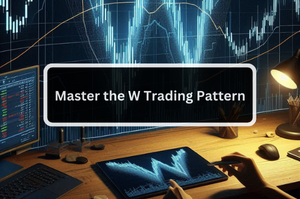Master the W Trading Pattern – Modest Money

The W trading pattern, commonly known as the double bottom, is a bullish reversal signal in technical analysis. It is distinguished by its double-bottom structure, which resembles the letter “W.” This pattern is formed when the price makes two distinct lows at a similar price level, separated by a temporary rally.
The significance of the pattern lies in its ability to signal the end of a downtrend and the start of an upward movement. The second bottom represents a level where buyers have taken control, driving the price back up and confirming a bullish reversal.
Formation and Market Psychology Behind the W Pattern
The W pattern usually forms after a significant price decline, indicating that the selling pressure is exhausted. The first bottom represents a low in the downtrend, followed by a brief rally as buyers temporarily push prices higher. This rally eventually meets resistance, and the price falls again to form the second bottom.
This second low is crucial because it indicates that buyers are once again stepping in to support the price. The psychology behind the W pattern is rooted in changing market sentiment, where sellers lose strength, and buyers regain control, signaling an impending bullish reversal.
Spotting the W Trading Pattern: Steps and Key Features
To identify the W trading pattern effectively:
- First Bottom: Look for a significant price decline that reaches a bottom, marking the end of the first downtrend.
- Brief Rally: After the first bottom, the price should briefly rally, indicating a temporary retracement or a resistance level.
- Second Bottom: The second bottom forms when the price falls again but finds support at a similar level to the first bottom, signifying that buyers are stepping in to establish a new support.
- Breakout Point: The pattern is confirmed when the price breaks above the resistance formed during the brief rally, indicating a bullish breakout.
Indicators That Complement the W Trading Pattern
Complementary technical indicators enhance the reliability of the W pattern:
- RSI (Relative Strength Index): The RSI helps identify oversold conditions that align with the pattern’s bullish implications. An RSI reading below 30 at the second bottom indicates a potentially oversold market, hinting at an upward reversal.
Learn More About RSI Divergence - MACD (Moving Average Convergence Divergence): The MACD helps spot bullish crossovers that align with the pattern’s upward breakout. A bullish MACD crossover, where the MACD line crosses above the signal line, confirms rising momentum.
- Moving Averages: Moving averages validate the broader trend direction. If the W pattern is confirmed above the 50-day or 200-day moving average, it strengthens the bullish reversal signal.
- Volume Analysis: Rising volume during the breakout enhances confidence in the pattern’s bullish reversal, indicating strong buying interest.
Integrate the W Pattern into Your Trading Strategies
To effectively integrate the W pattern into your trading strategies, consider the following approaches:
Entry Points
- Early Entry: After the second bottom forms, enter a long position anticipating the breakout. This strategy allows you to capture more of the upward move but carries a higher risk if the breakout does not occur.
- Breakout Entry: A safer entry point is waiting for the price to break above the resistance formed by the brief rally between the two bottoms. This approach confirms the breakout and reduces the risk of a false signal.
Stop-Loss Strategies
Place stop-loss orders just below the second bottom to protect against false reversals. This strategy limits losses if the price fails to break out and moves lower.
Profit Targets
Set profit targets based on key resistance levels or Fibonacci retracement levels. These levels provide realistic expectations for potential price movements, enabling you to lock in profits as the pattern unfolds.
Additional Strategies
- In trending markets, the W pattern serves as a confirmation signal to enter positions aligning with the broader trend.
- In sideways ranges, the W pattern can help traders identify potential breakouts from consolidation.
Related Chart Patterns You Should Know About
Double Top
The M trading pattern, also known as the double top, is the bearish counterpart to the W pattern. It forms after a significant price rally and signals a potential reversal when the price fails to break out above a resistance level.
Learn More About the Double Top
Cup and Handle Pattern
The cup and handle pattern has a similar continuation signal but a different structure. It features a rounded bottom (the cup) followed by a consolidation (the handle), often preceding an upward breakout.
Learn More About the Cup and Handle
Head and Shoulders Pattern
The head and shoulders pattern signals a bearish reversal, featuring a peak (the head) between two lower peaks (the shoulders). It contrasts with the W pattern by indicating a downward trend.
Learn More About the Head and Shoulders
Learn about many more chart patterns and improve your trading strategy – check out our comprehensive guide to master trading chart patterns.
Using Trading Tools to Identify the W Trading Pattern
TradingView
TradingView’s advanced charting tools are excellent for identifying and tracking the W pattern. The platform’s drawing tools allow you to outline the pattern accurately, and its alert system ensures you don’t miss potential trading opportunities.
TrendSpider
TrendSpider’s automated pattern recognition and multi-timeframe analysis are highly effective for swiftly identifying the W pattern. Its backtesting feature helps refine strategies using historical data, and its automated alerts notify you when a potential W pattern forms.
Final Thoughts on Mastering the W Trading Pattern
Mastering the W trading pattern requires understanding its structure, psychology, and how to integrate it with other technical indicators. This pattern offers valuable insights into market sentiment and signals potential bullish reversals.
By combining it with indicators like MACD, RSI, and moving averages, you can enhance the pattern’s predictive power and increase your trading accuracy. Leveraging advanced tools like TradingView and TrendSpider makes identifying and analyzing the pattern easier, empowering you to make informed decisions.
Related Links
Source link


